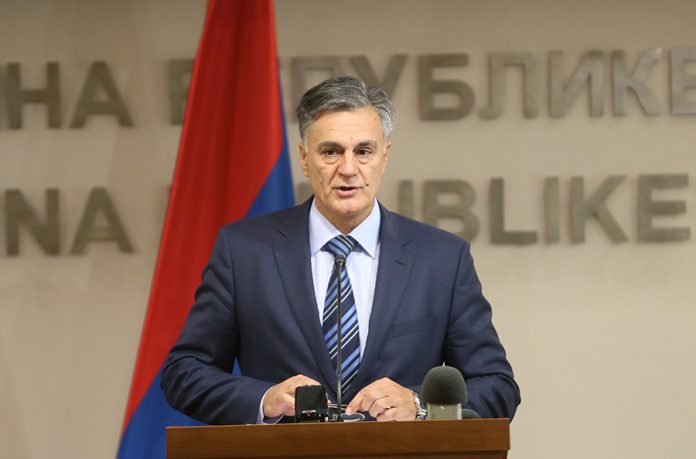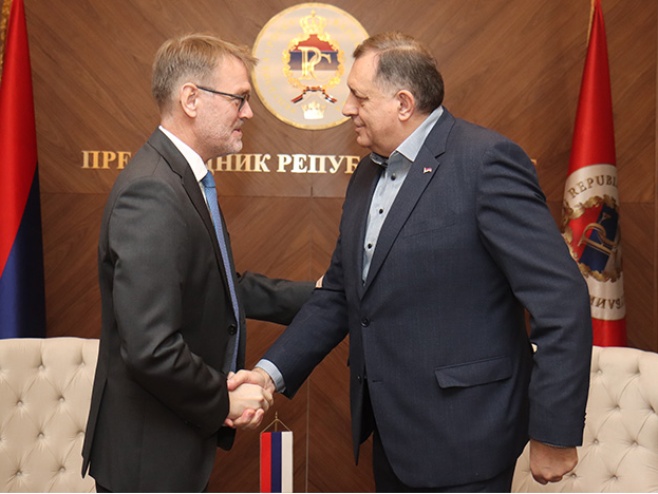Professor of Constitutional Law Siniša Karan emphasized that Republika Srpska was effectively a state with full capacity between 1992 and 1995.
In his column for Srna, Professor Karan reminded that Republika Srpska was recognized as an independent state twice in the period following the breakup of the Socialist Republic of Bosnia and Herzegovina (SR BiH) up to the Dayton Agreement. The first recognition came with the plan proposed by Thorvald Stoltenberg and David Owen in 1993, which suggested dividing Bosnia and Herzegovina into three republics in a confederal relationship.
The second recognition of Republika Srpska as a state was the Framework Agreement on Confederal Relations between the Republic of Croatia and the Bosniak-Croat Federation of Bosnia and Herzegovina, which was part of the overall arrangement in the process of creating the Federation of Bosnia and Herzegovina established by the Washington Agreement on March 18, 1994.
- “Self-determination is not secession; it is a universal right of all peoples, which can be justified by constitutional and societal circumstances. After all, both Republika Srpska and Bosnia and Herzegovina were created based on the principle of self-determination,” Karan pointed out.
According to him, the United States, with its arrogant foreign policy of false concern and balance, justifying itself by claiming it is not against Muslims, is continuously building a Muslim state in Bosnia and Herzegovina by using all means of influence as a tool against the Serbs.
- “Their destructive, warmongering, anti-Serb, and anti-Dayton policies openly support the creation of a Muslim unitarist Bosnia and Herzegovina under the guise of false concern for Muslims. The lack of recognition of this reality among present-day Bosniaks, whose very name and function aim to create a Muslim state, poses a serious threat to peace,” Karan emphasized.
Karan concluded that the future of Bosnia and Herzegovina is only possible by eliminating any influence from the United States, as well as the United Kingdom and Germany, from this region and ensuring the coexistence of three nations in a federal Bosnia and Herzegovina based on federal principles: division of competencies, parity in the composition of federal organs, and consensus in decision-making.
- “A disturbance of any of these three principles will inevitably lead to the disintegration of the normative constitutional order and society,” Karan warned.
Below is the complete column by Professor Siniša Karan:
How the SFR Yugoslavia and SR BiH dissolved and how Republika Srpska, FBiH, and BiH were created
The nature of Bosnia and Herzegovina’s state organization, as defined by the Constitution, for the first time became a complex federal state as a compromise in a multi-ethnic community.
The Dayton Peace Agreement is an international treaty, an act of international law. Of its 11 annexes, only Annex 4 – the Constitution of Bosnia and Herzegovina – can be amended, and that requires the consent of all three constituent peoples and a two-thirds majority in the House of Representatives of the Parliamentary Assembly of Bosnia and Herzegovina. The other annexes and the agreement itself cannot be changed; they must be applied according to the well-known legal rule – “pacta sunt servanda” (agreements must be kept).
The Constitution of Bosnia and Herzegovina definitively ends the constitutional and political continuity, establishing a new political order based on a federal model. While the entities are not defined as states, they have all the attributes of states similar to those in the United States. They have the right to enter into international agreements (with the consent of the Parliamentary Assembly of Bosnia and Herzegovina) and to establish special relationships with neighboring states.
Constitutionally, Bosnia and Herzegovina has a loose federal structure with elements of confederalism. The entities are the primary subjects of Bosnia and Herzegovina’s internal structure, with a high degree of autonomy, their own territories, and many elements of statehood. They are the fundamental principle of government organization in Bosnia and Herzegovina, complemented by the formula of the constituent peoples.
Today, Bosnia and Herzegovina is a federal state with an imposed constitution, the shortest in the world, with many constitutional gaps, ambiguities, and uncertainties, which, without formal constitutional amendments, has through interpretation and the power of international factors in its political life become a form of internationally protected state.
State sovereignty is shared between the state and federal units, the main holders of sovereignty in Bosnia and Herzegovina are the constituent peoples and entities
In a federal state, sovereignty is divided between the state and federal units, ensuring that no level of government can violate the powers of another.
According to the Constitution of Bosnia and Herzegovina, the main holders of sovereignty are the constituent peoples and the entities as federal units in all matters, except those specified in the Constitution as the competencies of the institutions of Bosnia and Herzegovina.
Entity sovereignty is expressed through the autonomous organization of the entity’s structure, the creation of its legal order, and the exercise of authority within each entity. The entities have their own constitutions, legislation, judiciary, administration, and finances.
Therefore, entities exercise powers derived from their own rights and, based on a certain degree of sovereignty, can assume rights and obligations in international law.
The entities have all the power on the internal level, possessing what is known as internal sovereignty, while Bosnia and Herzegovina has primarily external sovereignty for matters concerning international and foreign affairs.
Dissolution of the SFR Yugoslavia, Bosnia and Herzegovina is a newly formed state created by an international treaty of two state-building entities
The dissolution of Yugoslavia is a factual event that has not yet received a competent interpretation, but the causes of the breakup are primarily recognized in the constitutional elements of the state and within the state organization.
Slovenia, Croatia, and Macedonia formed new states through secession, Serbia and Montenegro formed a new state – the Federal Republic of Yugoslavia, while Bosnia and Herzegovina is a newly formed state created by an international treaty of two state-building entities.
Formally and legally, the political institutions of Bosnia and Herzegovina could not make any decision about secession from Yugoslavia because it would be contrary to the still valid Constitution of the SFR Yugoslavia. Therefore, the referendum on independence had no legal basis. A new problem arose when Yugoslavia ceased to exist.
By late 1991, and certainly by early 1992, Bosnia and Herzegovina had effectively ceased to be a state
By late 1991, and certainly by early 1992, Bosnia and Herzegovina no longer had sovereign authority. Thus, Bosnia and Herzegovina effectively ceased to be a state, as its institutions no longer functioned effectively across its entire territory, and its formation process took place between 1992 and 1995.
By the end of 1992, there were three state-forming units on the territory of Bosnia and Herzegovina: the Republic of Bosnia and Herzegovina (the Muslim part), Republika Srpska (the Serb part), and Herceg-Bosna (the Croatian part). All three units had the characteristics of national states, each with its own territory, army, police, government organization, its own currency, and other state institutions and symbols.
The international community knew that the recognition of Bosnia and Herzegovina in 1992 was only a political act (the SR BiH had dissolved), which is why the process of finding the most suitable model for the state organization of Bosnia and Herzegovina continued.
No international plan provides for a unitary Bosnia and Herzegovina
Peace proposals acknowledge the existence of three states and find solutions for a confederal relationship or a federal state. No plan provides for a unitary Bosnia and Herzegovina.
The first peace plan for Bosnia and Herzegovina, known as the Cutileiro Plan, was drafted in mid-1992. According to this plan, Bosnia and Herzegovina would be a state with three constituent units forming the Federal Republic of Bosnia and Herzegovina.
The next attempt to resolve the state organization of Bosnia and Herzegovina was the plan by UN envoy Cyrus Vance and EU envoy Lord David Owen, who in March 1993 proposed a peace plan that would make Bosnia and Herzegovina a federation with 10 cantons.
The third attempt to resolve the state organization in Bosnia and Herzegovina was the plan by Ambassador Thorvald Stoltenberg and Lord David Owen, proposed in 1993, which divided Bosnia and Herzegovina into three republics in a confederal relationship. A confederation is not a state but a union of states. This is the best indicator of the de facto recognition of Republika Srpska as a state.
The second recognition of Republika Srpska as a state is the Framework Agreement on Confederal Relations between the Republic of Croatia and the Bosniak-Croat Federation of Bosnia and Herzegovina, as part of the overall arrangement in the process of creating the Federation of Bosnia and Herzegovina, established by the Washington Agreement on March 18, 1994.
The fourth plan to resolve the crisis in Bosnia and Herzegovina was the Contact Group Plan in 1994, which divided Bosnia and Herzegovina into two units: the Federation of Bosnia and Herzegovina and Republika Srpska.
The final proposal for Bosnia and Herzegovina is the Dayton Peace Agreement, which established it as a complex confederal-federal state of two state-building units, accepted by all three peoples and ratified by the international community.
Bosnia and Herzegovina could not transform into an independent state, let alone a unitary one
Bosnia and Herzegovina could not transform from a federal unit of the former SFR Yugoslavia into an independent state, especially not a unitary one, for the simple reason that each of the three constituent peoples in Bosnia and Herzegovina had different approaches to this issue.
Since the Dayton Agreement, Republika Srpska has no longer been a state with full capacity, retaining internal sovereignty, while external sovereignty belongs to Bosnia and Herzegovina.
High representatives begin fundamental unconstitutional revision of the constitution of Bosnia and Herzegovina, which de facto became an occupied country
The erosion and attack on the agreed Dayton structure began immediately. The inability to expand the competencies of institutions at the level of Bosnia and Herzegovina through regular parliamentary procedures was compensated by the role of the High Representative and the Constitutional Court.
Between 1997 and 2007, High Representatives issued a total of 99 decisions concerning state symbols and matters at the level of Bosnia and Herzegovina, and constitutional needs, and a total of 88 decisions regarding individuals suspected of war crimes committed in the former Yugoslavia. Simultaneously, political declarations for the implementation of peace in Bosnia and Herzegovina give political guidelines to the High Representative and practically conduct a fundamental unconstitutional revision of the Constitution of Bosnia and Herzegovina.
Thus, Bosnia and Herzegovina de facto became an occupied country. The unconstitutional transfer of competencies has taken such a form and quantum that it can be freely stated that the Constitution no longer exists and has been replaced by de facto unconstitutionality.
The process of constituting Republika Srpska
Following the dissolution of the SR BiH, Republika Srpska emerged as an expression of the will of the people and the universal rights of the constituent people, whereby every people has the right to its own state, whether with full or limited sovereignty and whether independent or part of a complex state of any form, such as a union, confederation, or federation.
The constitutiveness of the people means that the people have their own self-origin, autochthony, a specific culture, and historical-religious, national, and other particularities.
The right of peoples to self-determination is explicitly established by numerous international acts: the Resolution of the London Congress in 1896, the Program of the International in 1903, the Charter of the United Nations in 1945, which legalized the right to self-determination. In 1976, the Covenant on Economic, Social, Political, and Other Rights was adopted, which, in its first article, establishes the right of peoples to self-determination.
The process of forming Republika Srpska took place simultaneously with the process of resolving the status of Bosnia and Herzegovina, with Republika Srpska being constituted in 1992 and Bosnia and Herzegovina in 1995.
Republika Srpska was created both factually and normatively, i.e., de facto and de jure. It was factually created because it had territory, population, and organized authority. Normatively, the process of constituting and adopting constitutional acts began in the fall of 1991.
Significant constitutive (constitutional) acts were adopted. The first act was the Decision to Establish the Assembly of the Serbian People in Bosnia and Herzegovina on October 24, 1991. The second act was the Decision on the Stay of the Serbian People in Bosnia and Herzegovina in the Joint State of Yugoslavia, adopted by the Assembly on October 24, 1991, and confirmed by the people in a plebiscite on November 9 and 10 of the same year.
The third act was the Declaration on the Proclamation of the Republic of the Serb People of Bosnia and Herzegovina. The fourth act was the Constitution of the Serb Republic of Bosnia and Herzegovina (later Republika Srpska), adopted by the Assembly of the Serb People in Bosnia and Herzegovina on February 28, 1992.
The Constitutional Law for the Implementation of the Constitution of Republika Srpska is also one of the significant acts of a constitutional nature. The sixth constitutive act was the Declaration on the State and Political Organization of the State, adopted on August 12, 1992, which has the character of a constitutional act, particularly a constitutional law or constitutional amendments. The Declaration determines the new name of the Republic, which is no longer called the Republic of the Serbian People of Bosnia and Herzegovina but Republika Srpska, and defines the state symbols: the anthem, flag, and coat of arms. All three symbols are traditional, i.e., the anthem “Bože pravde,” the tricolor flag (red-blue-white), and the Nemanjić coat of arms.
Thus, Republika Srpska was effectively a state with full capacity between 1992 and 1995.
However, the state-forming legal status of Republika Srpska today is determined by its place and role as a federal unit within the complex federal multi-ethnic Bosnia and Herzegovina.
Source: RTRS









